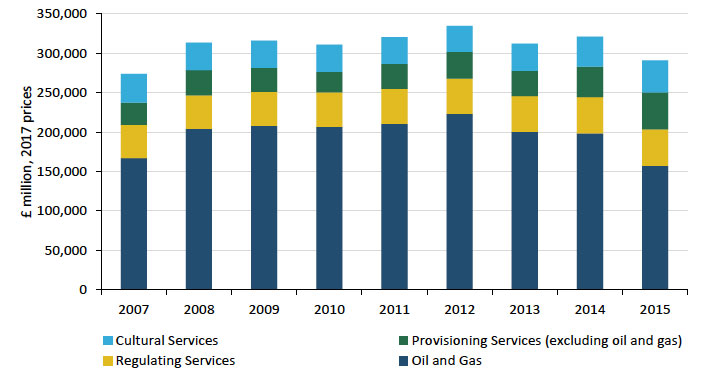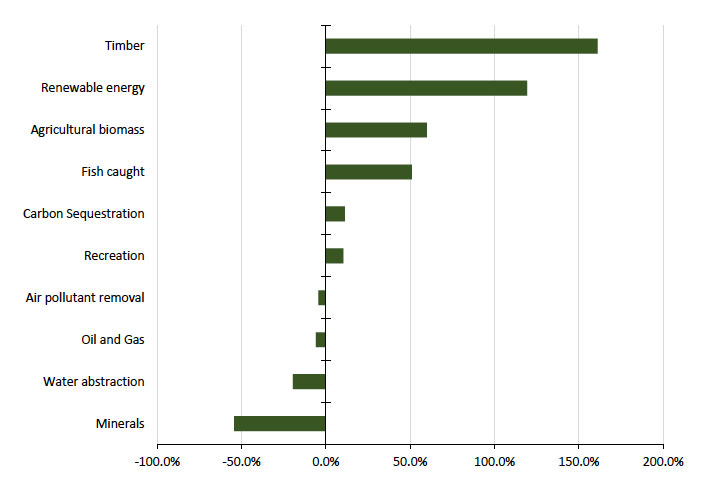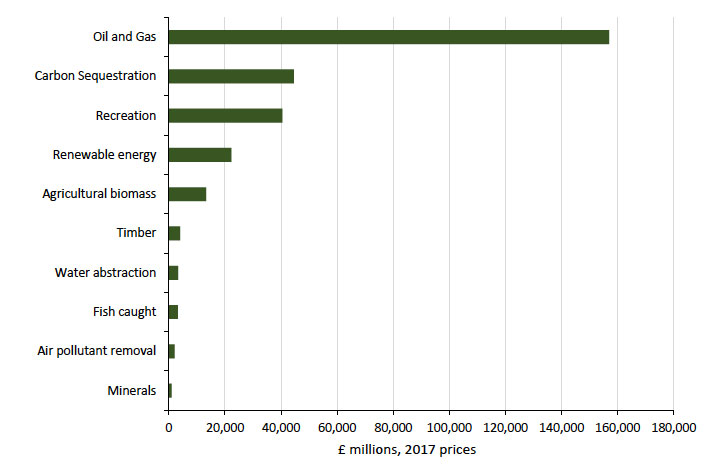Scottish natural capital: ecosystem service accounts 2019
This publication, prepared by the Office of National Statistics (ONS), presents estimates of the quantity and value of ten services being supplied by Scottish natural capital.
8. Asset valuation
Natural capital asset values
The production of oil and gas makes up the majority of total asset valuation in Scotland
Figure 25 presents the Scottish natural capital asset values between 2007 and 2015 by service. The asset values are estimated by capitalising the annual flow of services from the natural resource that are expected to take place over a projected period. This period is known as the asset life. The annual environmental service flows provide the basis for the projected flows. This method, known as net present valuation (NPV), is explained in more detail in the methodology Section 9 of this article.
The majority of the environmental services presented in this article are produced from renewable resources whose stock is not exhausted over time, for example, Scottish woodland delivering carbon sequestration. For renewable resources, a 100-year asset life has been assumed. The non-renewable abiotic resources presented in this article are minerals, and oil and gas, where an asset life of 25 years has been assumed.
The overall natural capital asset value in Scotland fluctuated between the years 2007 to 2015 (see Figure 25), with asset values reaching a low of £273,860 million in 2007 and a peak of £334,825 million in 2012. In 2015, assets in Scotland were valued at £290,925 million. In 2016 and 2017, it is projected that the overall natural capital asset value will fall due to further decline in the oil and gas asset valuation.
Figure 25: The oil and gas production makes up the majority of Scotland’s natural capital asset value
Asset valuation by service, Scotland, 2007 to 2015

Source: Office for National Statistics
Between the years 2007 and 2015, asset values for the majority of Scottish services increased (see Figure 26). In fact, asset values for both timber and renewable energy more than doubled in this time frame. In contrast, the asset value of minerals has more than halved in this time period.
Figure 26: Between the years 2007 to 2015, the majority of services natural capital asset value increased
Percentage change in asset value by service from 2007, Scotland, 2015

Source: Office for National Statistics
Despite the asset value of oil and gas falling by 6% between the years 2007 and 2015, this sector still made up a large proportion of the asset value of natural capital in Scotland, making up 54% of the total Scottish asset value in 2015 (see Figure 27).
In recent years, the asset value of oil and gas has decreased whilst the asset value of renewable energy has increased. Carbon sequestration was the second-largest contributor towards total asset valuation, making up 15.3% of the asset value in 2015. The overall asset value of non-material services not directly captured in gross domestic product (GDP) (that is, regulating services and cultural services) represented 30% of Scotland’s asset value in 2015.
Figure 27: Oil and gas accounts for over half of total asset values in 2015
Asset value by service, Scotland, 2015.

Source: Office for National Statistics
With fluctuations, neither the Scottish nor UK overall natural capital asset valuations have clear positive or negative trends. While the natural capital asset valuation in the UK has generally shown slight annual increases, like Scotland, forthcoming overall asset valuations will be increasingly impacted by the fall in the production of oil and gas in Scotland.
Between the years 2009 and 2015, the value of Scotland’s natural capital assets made up on average 40% of total UK natural capital assets, largely due to the significant contribution of Scottish oil and gas. Alongside the reduction in oil and gas asset valuation, the contribution of Scotland’s natural capital decreased to 37% of UK valuation in 2015.
Contact
There is a problem
Thanks for your feedback